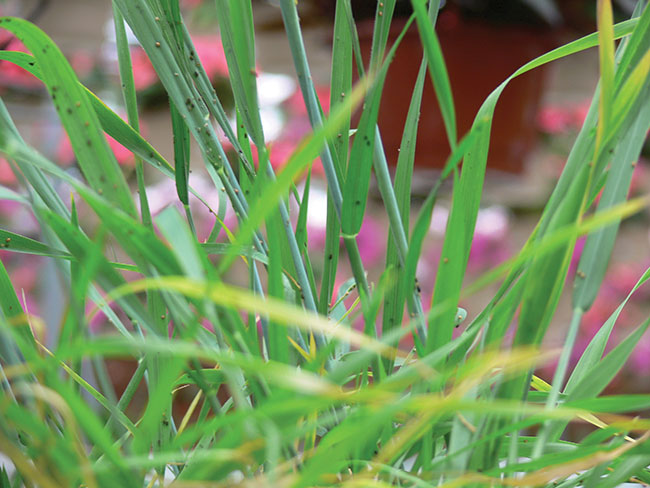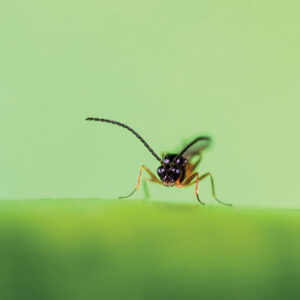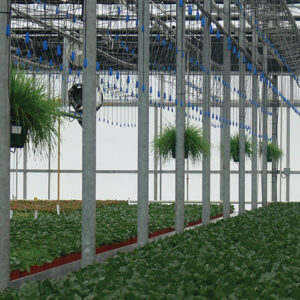
Features
The basics of banker plants
Everything you need to know about the cheap and efficient system for producing your own biological controls
March 4, 2024 By Ashley Paling
 Figure 1. Rhopalosiphum padi on a banker plant.
Photo by OMAFRA.
Figure 1. Rhopalosiphum padi on a banker plant.
Photo by OMAFRA. Employing biological controls as part of an Integrated Pest Management (IPM) strategy is a popular choice among growers and is proven to be successful at controlling pest populations when done properly (Jacob, 2023). Biologicals can be purchased weekly from suppliers like Koppert or BioBest, however this is an expensive option that leaves you at the mercy of waiting for weekly deliveries to control your greenhouse pests. Enter the Banker Plant System: a relatively inexpensive option that provides you with a constant supply of beneficial biological controls. This article covers the ins and outs of how to use this system properly, and what you need to consider if you are going to begin your own Banker Plant System in your greenhouse.
The Banker Plant System: What is it?
The Banker Plant System (BPS) is a self-contained system that uses a non-pest on a non-crop plant to rear beneficial insects to control your greenhouse pests (Jandricic and Frank, 2014; Skinner et al. 2016). While this system can be set up to control a variety of pests, one of the most common options is the Aphidius colemani (figure 2) BPS to control aphids (Skinner et al. 2016). In the case of this system, the non-pest used is the Bird Cherry Oat Aphid (Rhopalosiphum padi), which is a pest to monocot species. These aphids feed on a monocot crop such as oats, wheat, rye, or barley. The beneficial insects A. colemani, are parasitic wasps, and use the R. padi to lay eggs and grow their own population (Huang et al. 2011; Koppert, 2016). The main reason this works is because the majority of commercial greenhouse bedding plants or vegetables are dicots, and the R. padi will not become a pest for your saleable crops (Frank Sullivan & Skinner, 2013; Skinner et al. 2016). A. colemani works best at controlling green peach aphids (Myzus persicae) and cotton/melon aphids (Aphis gossypii) specifically, so identifying the aphid pest in your greenhouse properly is important for this system’s success (Skinner et al. 2016). By continuously producing new monocot banker plants to rear your R. padi and A. colemani populations, you can have a long-term supply of beneficial biologicals.
Step by step: Creating your own banker plant system
Materials you will need to create your own BPS: cages or hairnets, pots, planting media, grain seed (barley or wheat work best; Jandricic 2014), R. padi, A. colemani, water, and fertilizer.
Week 1: Seed your first few banker plants, adding fertilizer and watering well. You will need to start with a minimum of two banker plants per acre of growing space and follow up with at least one new banker plant per acre each week (Jacob, 2023; Skinner et al. 2016). Inoculate these newly seeded pots with your starting population of R. padi. Immediately place these pots in a cage or under a hairnet, to keep the A. colemani away from your plants until the R. padi population has built up.
Week 2: Seed another round of new banker plants as you did in week one, and place them immediately under protection, so they don’t get infested with any flying A. colemani in your greenhouse too early. Take 3 – 5 blades with R. padi from your one-week-old plant (see Figure 1) and place them directly on your newly seeded plants from this week under protection (Skinner et al. 2016).
Week 3: Continue seeding and inoculating new plants as in weeks 1 and 2. Evaluate the population of your R. padi from the week 1 plants this week. If they are abundant (at least 10 R. padi per blade), release 100 A. colemani into each pot. Place them under the hair nets or in the cages so they don’t fly away initially (Koppert, 2023). Continue watering and fertilizing plants as necessary.
Week 4: Continue seeding and inoculating new plants as in weeks 1 and 2. Take the banker plants you planted in week 1, which now also have A. colemani, and evaluate the A. colemani population. If you can see R. padi mummies with exit holes and A. colemani flying around, remove the net and place them around the greenhouse (as in the photo on the left). If you only have a small population of mummified R. padi, hold off on releasing for one more week. Continue watering and fertilizing plants as necessary.
To keep the population of your A. colemani growing and predating on your pest aphids, continue seeding and inoculating new banker plants with R. padi then A. colemani for a total of five or six weeks (Jacob, 2023; Skinner et al. 2016). At this point, after having followed the above schedule, the A. colemani population should be well established in your greenhouse and should not need replenishing. Ensure you are continuously providing the A. colemani population with fresh banker plants inoculated with R. padi each week.
The pros and cons of a banker plant system
Like all pest management strategies, there are both pros and cons for the A. colemani banker plant system.
Knowing the challenges of the banker plant system can help you know what to expect, and prepare you for troubleshooting issues before you start.
However, the positives outweigh the negatives for this strategy, which has been widely accepted and adopted in many growing regions.
CONS
- Requires consistent watering, fertilization, and monitoring the status of your banker plants. If watering is missed and your banker plants begin to suffer, so does your beneficial population.
- May have different water and nutrient needs than your crop, so think about how you’ll take care of them before you grow. Some growers hand-water; others put them on separate watering lines. Different potting mixes that hold water differently are also an option.
- Not appropriate for some monocot crops like Easter Lilies or ornamental grasses, since the R. padi would be at risk of becoming a pest to your saleable crops (Skinner et al. 2016).
PROS
- This is an inexpensive way to produce a large amount of A. colemani compared to purchasing new biologicals every week.
- Can be applied to a wide variety of commercially grown dicot crops.
- Can help you monitor the health and activity of your parasitoid population (by looking for mummies on the bankers).
- Provides parasitoids that are “fresher” (Jandricic and Frank 2014) that can be more effective than wasps from commercial sources.
- Wasps are more recently hatched, meaning they have their whole life span (7 – 10 days [Jacob, 2023]) to parasitize aphids in your greenhouse.
5 top tips for growers trying this system!
- This system is preventative, not reactionary! You need to be able to get ahead of the pest pressure for it to work effectively. The best timing is to start your banker plant system six weeks before your earliest expected crop that regularly gets aphids will be planted in your greenhouse (Skinner et al. 2016).
- Be consistent with your watering! There is nothing more disappointing than seeing your pest populations rise because you had some wilted banker plants over the weekend.
- Remember that your banker plants need fertilizer too! Just as it is important to remember to water your banker plants, so too is it crucial to ensure they are receiving fertilizer when they need it. Hooking up your banker plants to a drip line that gets regularly fertigated is a good way to avoid forgetting them.
- Make sure your cages or hair nets are air tight! Having a fully secured environment to keep your A. colemani from parasitizing the R. padi population before it has a chance to multiply is extremely important.
- The type of monocot crop you use for your banker plant does matter! Oats have been determined to be the least effective, providing you with lower R. padi populations and therefore less parasitoids. Wheat and barley provide the R. padi with the most nutrients, which lead to healthier A. colemani populations (Jandricic and Frank 2014).
By following these steps and helpful tips, you should be able to have your own Banker Plant System up and running, providing your greenhouse with a constant supply of beneficials, in no time!
Ashley Paling is a part-time professor with the School of Environment & Horticulture at Niagara College. These observations were made when she was a Research Assistant with the Horticultural & Environmental Sciences Innovation Centre and taking a Greenhouse Production Science course led by Sebastien Jacobs.
- References
Anatis Bioprotection. (2023). Aphid Banker Plants. Anatis Bioprotection Products. Retrieved on April 13th, 2023 from https://anatisbioprotection.com/en/biological-control-products/aphids-banker-plant-system/ - Frank Sullivan, C. E., & Skinner, M. (2013). Plant-mediated IPM systems explained. University of Vermont Entomology Research Laboratory.
- Huang, N., Enkegaard, A., Osborne, L., Ramakers, P., Messelink, G., Pijnakker, J., & Murphy, G. (2011). The banker plant method in biological control. Critical Reviews in Plant Science, 30: 259-278.
- Jacob, S. (2023). Unit 1 – Banker Plants. Blackboard Presentation.
- Jandricic, S., and Frank, S. (2014). Boosting bankers. Greenhouse Canada. Retrieved on April 6th, 2023 from https://www.greenhousecanada.com/boosting-bankers-4310/
- Koppert Canada Ltd. (2016). Biological control of aphids – Aphidius colemani. YouTube Video Retrieved on April 6th, 2023 from https://www.youtube.com/watch?v=StSO7LSzzAw
- Koppert Canada Ltd. (2023). Aphipar. Retrieved on April 6th, 2023 from https://retail.koppert.ca/products/aphipar
- Skinner, M., Frank Sullivan, C. E., & Valentin, R. (2016). Aphid banker plant system for greenhouse IPM, step by step. University of Vermont Entomology Research Laboratory.
Print this page

